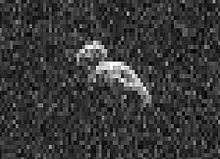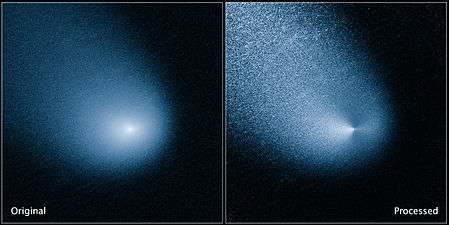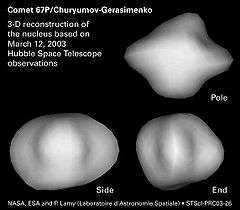2013 FY27
| Discovery[1] | |
|---|---|
| Discovered by |
Scott Sheppard Chad Trujillo (807) |
| Discovery date |
17 March 2013 announced: 31 March 2014 |
| Designations | |
| MPC designation | 2013 FY27 |
| TNO, SDO[2] | |
| Orbital characteristics[3] | |
| Epoch 13 January 2016 (JD 2457400.5) | |
| Uncertainty parameter 7 | |
| Observation arc | 1054 days (2.89 yr) |
| Aphelion | 81.8481 AU (12.24430 Tm) (Q) |
| Perihelion | 36.0577 AU (5.39416 Tm) (q) |
| 58.9529 AU (8.81923 Tm) (a) | |
| Eccentricity | 0.38836 (e) |
| 452.65 yr (165332 d) | |
| 209.4711° (M) | |
| 0° 0m 7.839s /day (n) | |
| Inclination | 32.9890° (i) |
| 187.1719° (Ω) | |
| 139.623° (ω) | |
| Earth MOID | 35.111 AU (5.2525 Tm) |
| Jupiter MOID | 31.4167 AU (4.69987 Tm) |
| Physical characteristics | |
| Dimensions |
780 km (Brown)[4] 530[lower-alpha 1]–1100[lower-alpha 2] km[3][5] 900 km[6] |
|
0.1 to 0.4? (assumed range) 0.15 (theoretically expected value)[4] | |
| 22.1 | |
|
3.0 (JPL/MPC)[3] 3.2 (Brown)[4] | |
|
| |
2013 FY27, also written 2013 FY27, is a trans-Neptunian object[3] that belongs to the scattered disc (like Eris).[6] Its discovery was announced on 31 March 2014.[1] It has an absolute magnitude (H) of 3.0,[3] which makes it very likely to be a dwarf planet.[4] Assuming an albedo of 0.15, it would be approximately 850 kilometres (530 mi) in diameter.[5] It is the ninth-intrinsically-brightest known trans-Neptunian object,[7] and is the largest unnumbered minor planet as of October 2015.
2013 FY27 will come to perihelion around 2198,[lower-alpha 3] at a distance of about 36 AU.[3] It is currently near aphelion, 80 AU from the Sun, and, as a result, it has an apparent magnitude of 22.[1] Its orbit has a significant inclination of 33°.[3]
First observed on 17 March 2013, it has an observation arc of about one year.[3] It came to opposition in early March 2014.
The sednoid 2012 VP113 and the scattered-disc object 2013 FZ27 were discovered by the same survey as 2013 FY27 and were announced within about a week of one another.
| Object name | Distance from the Sun (AU) | Apparent magnitude |
Absolute magnitude (H) | |||||||||||||||||||||||||||||||||||||||||||||||||||||||||||||||||||||||||||||||||||||||||||||||
|---|---|---|---|---|---|---|---|---|---|---|---|---|---|---|---|---|---|---|---|---|---|---|---|---|---|---|---|---|---|---|---|---|---|---|---|---|---|---|---|---|---|---|---|---|---|---|---|---|---|---|---|---|---|---|---|---|---|---|---|---|---|---|---|---|---|---|---|---|---|---|---|---|---|---|---|---|---|---|---|---|---|---|---|---|---|---|---|---|---|---|---|---|---|---|---|---|---|---|
| Current | Perihelion | Aphelion | ||||||||||||||||||||||||||||||||||||||||||||||||||||||||||||||||||||||||||||||||||||||||||||||||
| V774104 | 103 | N/A | N/A | 24 | 4 | |||||||||||||||||||||||||||||||||||||||||||||||||||||||||||||||||||||||||||||||||||||||||||||
| Eris | 96.2 | 37.8 | 97.6 | 18.7 | -1.2 | |||||||||||||||||||||||||||||||||||||||||||||||||||||||||||||||||||||||||||||||||||||||||||||
| 2014 UZ224 | 91.6 | 38.0 | 179.8 | 23.2 | 3.5 | |||||||||||||||||||||||||||||||||||||||||||||||||||||||||||||||||||||||||||||||||||||||||||||
| 2007 OR10 | 87.6 | 33.0 | 100.8 | 21.7 | 2.5 | |||||||||||||||||||||||||||||||||||||||||||||||||||||||||||||||||||||||||||||||||||||||||||||
| 2013 FS28 | 86.2 | 34.6 | 347.6 | 24.5 | 4.9 | |||||||||||||||||||||||||||||||||||||||||||||||||||||||||||||||||||||||||||||||||||||||||||||
| Sedna | 85.6 | 76.0 | 939 | 21.0 | 1.6 | |||||||||||||||||||||||||||||||||||||||||||||||||||||||||||||||||||||||||||||||||||||||||||||
| 2014 FC69 | 84.4 | 40.3 | 106.9 | 24.1 | 4.6 | |||||||||||||||||||||||||||||||||||||||||||||||||||||||||||||||||||||||||||||||||||||||||||||
| 2006 QH181 | 83.6 | 37.8 | 96.7 | 23.6 | 4.3 | |||||||||||||||||||||||||||||||||||||||||||||||||||||||||||||||||||||||||||||||||||||||||||||
| 2012 VP113 | 83.3 | 80.5 | 438 | 23.4 | 4.0 | |||||||||||||||||||||||||||||||||||||||||||||||||||||||||||||||||||||||||||||||||||||||||||||
| 2013 FY27 | 80.2 | 36.1 | 81.8 | 22.1 | 3.0 | |||||||||||||||||||||||||||||||||||||||||||||||||||||||||||||||||||||||||||||||||||||||||||||
| 2014 FJ72 | 71.1 | 38.7 | 152.2 | 24.2 | 5.6 | |||||||||||||||||||||||||||||||||||||||||||||||||||||||||||||||||||||||||||||||||||||||||||||
| 2010 GB174 | 71.1 | 48.7 | 693 | 25.1 | 6.5 | |||||||||||||||||||||||||||||||||||||||||||||||||||||||||||||||||||||||||||||||||||||||||||||
| 2012 FH84 | 68.6 | 45.8 | 80.6 | 25.7 | 7.3 | |||||||||||||||||||||||||||||||||||||||||||||||||||||||||||||||||||||||||||||||||||||||||||||
| 2011 GM89 | 68.3 | 37.2 | 68.8 | 25.6 | 7.1 | |||||||||||||||||||||||||||||||||||||||||||||||||||||||||||||||||||||||||||||||||||||||||||||
| 2015 GR50 | 68.2 | 35.6 | 78.6 | 25.1 | 6.7 | |||||||||||||||||||||||||||||||||||||||||||||||||||||||||||||||||||||||||||||||||||||||||||||
| 2015 GP50 | 68.1 | 35.9 | 89.1 | 24.8 | 6.5 | |||||||||||||||||||||||||||||||||||||||||||||||||||||||||||||||||||||||||||||||||||||||||||||
| 2013 FQ28 | 67.5 | 48.7 | 80.6 | 24.4 | 6.0 | |||||||||||||||||||||||||||||||||||||||||||||||||||||||||||||||||||||||||||||||||||||||||||||
| 2013 UJ15 | 64.4 | 36.3 | 69.2 | 25.2 | 7.0 | |||||||||||||||||||||||||||||||||||||||||||||||||||||||||||||||||||||||||||||||||||||||||||||
| 2015 RR245 | 63.9 | 33.7 | 129.2 | 22.1 | 3.9 | |||||||||||||||||||||||||||||||||||||||||||||||||||||||||||||||||||||||||||||||||||||||||||||
| 2014 SG350 | 63.0 | 39.9 | 63.9 | 24.8 | 6.8 | |||||||||||||||||||||||||||||||||||||||||||||||||||||||||||||||||||||||||||||||||||||||||||||
| 2014 FL72 | 62.1 | 38.2 | 170.4 | 25.0 | 6.8 | |||||||||||||||||||||||||||||||||||||||||||||||||||||||||||||||||||||||||||||||||||||||||||||
| 2013 AT183 | 62.1 | 36.0 | 88.1 | 22.0 | 4.7 | |||||||||||||||||||||||||||||||||||||||||||||||||||||||||||||||||||||||||||||||||||||||||||||
| 2014 FE72 | 61.8 | 36.3 | 4274.0 | 24.1 | 6.1 | |||||||||||||||||||||||||||||||||||||||||||||||||||||||||||||||||||||||||||||||||||||||||||||
| 2014 SV349 | 61.3 | 34.2 | 89.0 | 23.0 | 5.0 | |||||||||||||||||||||||||||||||||||||||||||||||||||||||||||||||||||||||||||||||||||||||||||||
| 2000 CR105 | 60.8 | 44.3 | 412 | 23.9 | 6.3 | |||||||||||||||||||||||||||||||||||||||||||||||||||||||||||||||||||||||||||||||||||||||||||||
| 2014 SU349 | 60.7 | 30.8 | 109.8 | 25.0 | 7.0 | |||||||||||||||||||||||||||||||||||||||||||||||||||||||||||||||||||||||||||||||||||||||||||||
| 2014 FF72 | 60.7 | 37.1 | 63.3 | 24.8 | 6.9 | |||||||||||||||||||||||||||||||||||||||||||||||||||||||||||||||||||||||||||||||||||||||||||||
| 2014 FM72 | 60.4 | 34.4 | 76.6 | 24.1 | 6.2 | |||||||||||||||||||||||||||||||||||||||||||||||||||||||||||||||||||||||||||||||||||||||||||||
| 2014 FH72 | 60.1 | 37.3 | 77.3 | 25.1 | 7.2 | |||||||||||||||||||||||||||||||||||||||||||||||||||||||||||||||||||||||||||||||||||||||||||||
| 2008 ST291 | 60.1 | 42.4 | 154.5 | 22.2 | 4.2 | |||||||||||||||||||||||||||||||||||||||||||||||||||||||||||||||||||||||||||||||||||||||||||||
| 2003 QX113 | 60.0 | 36.7 | 62.1 | 22.5 | 4.7 | |||||||||||||||||||||||||||||||||||||||||||||||||||||||||||||||||||||||||||||||||||||||||||||
| 2015 KH162 | 59.2 | 41.5 | 82.8 | 21.6 | 3.9 | |||||||||||||||||||||||||||||||||||||||||||||||||||||||||||||||||||||||||||||||||||||||||||||
| Including all known objects currently located at least twice as far as Neptune.[8] See List of trans-Neptunian objects for more. | ||||||||||||||||||||||||||||||||||||||||||||||||||||||||||||||||||||||||||||||||||||||||||||||||||
See also
Notes
References
- 1 2 3 "MPEC 2014-F82 : 2013 FY27". IAU Minor Planet Center. 2014-03-31. Retrieved 2014-03-31. (K13F27Y)
- ↑ "List Of Centaurs and Scattered-Disk Objects". Minor Planet Center. Retrieved 2014-04-02.
- 1 2 3 4 5 6 7 8 9 "JPL Small-Body Database Browser: (2013 FY27)" (last observation: 2014-03-26; arc: 1.02 years). Jet Propulsion Laboratory. Retrieved 3 April 2016.
- 1 2 3 4 Mike Brown, How many dwarf planets are there in the outer solar system? Archived October 18, 2011, at the Wayback Machine. (assumes H = 3.3)
- 1 2 Dan Bruton. "Conversion of Absolute Magnitude to Diameter for Minor Planets". Department of Physics & Astronomy (Stephen F. Austin State University). Archived from the original on 2011-07-23. Retrieved 2014-03-26.
- 1 2 Lakdawalla, Emily (2014-04-02). "More excitement in the outermost solar system: 2013 FY27, a new dwarf planet". Planetary Society blogs. The Planetary Society. Retrieved 2014-04-02. External link in
|work=(help) - ↑ "JPL Small-Body Database Search Engine: orbital class (TNO) and H < 3.1 (mag)". JPL Solar System Dynamics. Retrieved 2014-03-31.
- 1 2 "AstDyS-2, Asteroids - Dynamic Site". 2016-02-26. Retrieved 2016-02-29.
Objects with distance from Sun over 59 AU
External links
- Orbital simulation from JPL (Java) / Horizons Ephemeris
- Celestia Files of the recent Dwarf Planet finds (Ian Musgrave: April 6, 2014)
- Gaggle of dwarf planets found by dark energy camera (Aviva Rutkin: 2 April 2014)
- 2013 FY27 at the JPL Small-Body Database

_(cropped).jpg)



